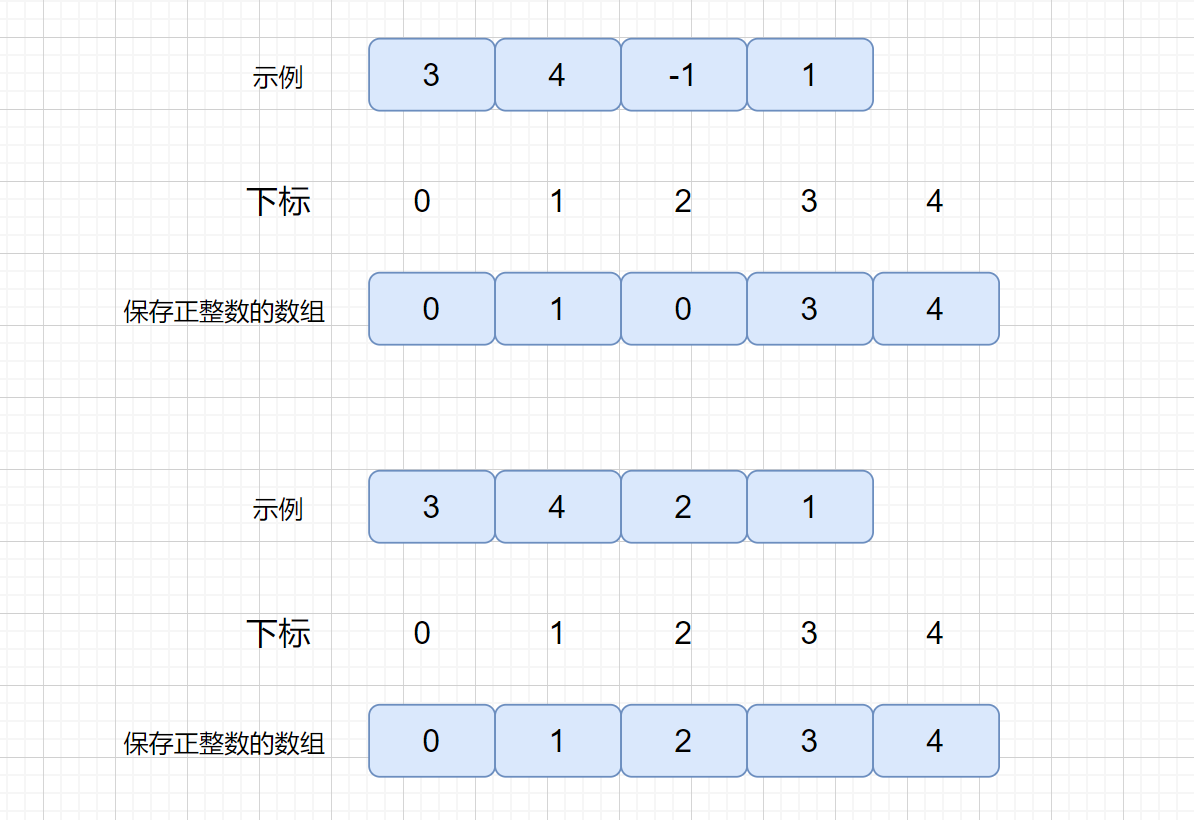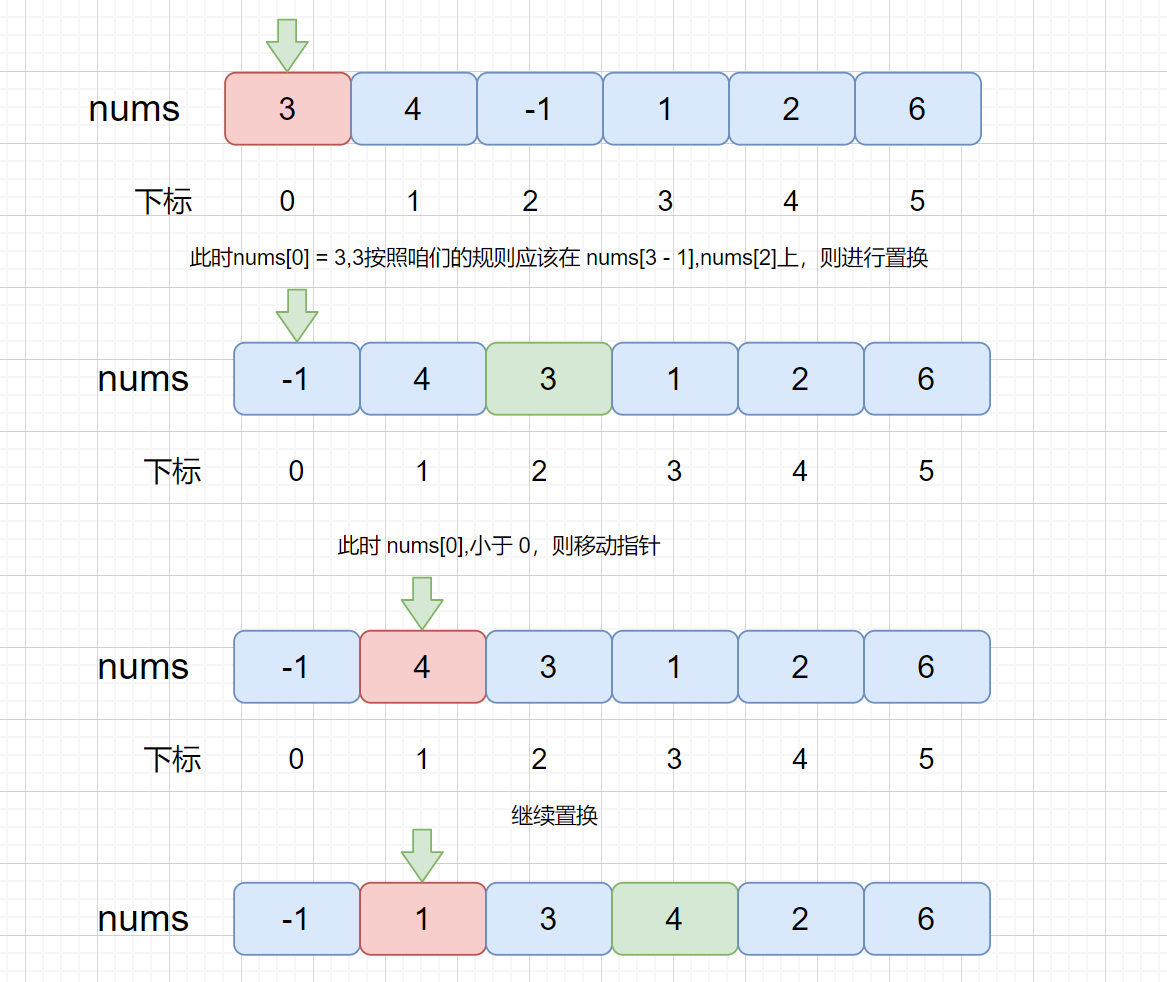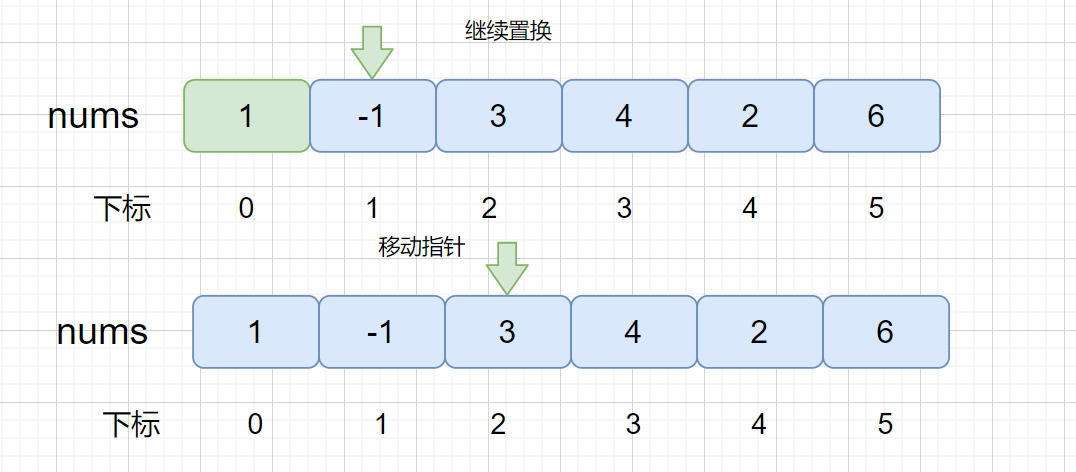299 lines
9.3 KiB
Markdown
299 lines
9.3 KiB
Markdown
> 如果阅读时,发现错误,或者动画不可以显示的问题可以添加我微信好友 **[tan45du_one](https://raw.githubusercontent.com/tan45du/tan45du.github.io/master/个人微信.15egrcgqd94w.jpg)** ,备注 github + 题目 + 问题 向我反馈
|
||
>
|
||
> 感谢支持,该仓库会一直维护,希望对各位有一丢丢帮助。
|
||
>
|
||
> 另外希望手机阅读的同学可以来我的 <u>[**公众号:袁厨的算法小屋**](https://raw.githubusercontent.com/tan45du/test/master/微信图片_20210320152235.2pthdebvh1c0.png)</u> 两个平台同步,想要和题友一起刷题,互相监督的同学,可以在我的小屋点击<u>[**刷题小队**](https://raw.githubusercontent.com/tan45du/test/master/微信图片_20210320152235.2pthdebvh1c0.png)</u>进入。
|
||
|
||
#### [41. 缺失的第一个正数](https://leetcode-cn.com/problems/first-missing-positive/)
|
||
|
||
给你一个未排序的整数数组,请你找出其中没有出现的最小的正整数。
|
||
|
||
示例 1:
|
||
|
||
> 输入: [1,2,0]
|
||
> 输出: 3
|
||
|
||
示例 2:
|
||
|
||
> 输入: [3,4,-1,1]
|
||
> 输出: 2
|
||
|
||
示例 3:
|
||
|
||
> 输入: [7,8,9,11,12]
|
||
> 输出: 1
|
||
|
||
### 重复遍历
|
||
|
||
让我们找出缺失的最小正整数,而且这是一个未排序的数组,我们可以利用暴力求解,挨个遍历发现那个不存在直接返回即可。我们这里使用两种方法解决这个问题,大家也可以提出自己的做法。
|
||
|
||
我们既然是返回缺失的正整数,那么我们则可以将这个数组中的所有正整数保存到相应的位置,见下图。
|
||
|
||

|
||
|
||
上图中,我们遍历一遍原数组,将正整数保存到新数组中,然后遍历新数组,第一次发现 newnum[i] != i 时,则说明该值是缺失的,返回即可,例如我上图中的第一个示例中的 2,如果遍历完新数组,发现说所有值都对应,说明缺失的是 新数组的长度对应的那个数,比如第二个示例中 ,新数组的长度为 5,此时缺失的为 5,返回长度即可,很容易理解。
|
||
|
||
注:我们发现我们新的数组长度比原数组大 1,是因为我们遍历新数组从 1,开始遍历。
|
||
|
||
动图解析
|
||
|
||

|
||
|
||
Java Code:
|
||
|
||
```java
|
||
class Solution {
|
||
public int firstMissingPositive(int[] nums) {
|
||
if (nums.length == 0) {
|
||
return 1;
|
||
}
|
||
//因为是返回第一个正整数,不包括 0,所以需要长度加1,细节1
|
||
int[] res = new int[nums.length + 1];
|
||
//将数组元素添加到辅助数组中
|
||
for (int x : nums) {
|
||
if (x > 0 && x < res.length) {
|
||
res[x] = x;
|
||
}
|
||
}
|
||
//遍历查找,发现不一样时直接返回
|
||
for (int i = 1; i < res.length; i++) {
|
||
if (res[i] != i) {
|
||
return i;
|
||
}
|
||
}
|
||
//缺少最后一个,例如 1,2,3此时缺少 4 ,细节2
|
||
return res.length;
|
||
}
|
||
}
|
||
```
|
||
|
||
Python3 Code:
|
||
|
||
```python
|
||
from typing import List
|
||
class Solution:
|
||
def firstMissingPositive(self, nums: List[int])->int:
|
||
if len(nums) == 0:
|
||
return 1
|
||
# 因为是返回第一个正整数,不包括 0,所以需要长度加1,细节1
|
||
res = [0] * (len(nums) + 1)
|
||
# 将数组元素添加到辅助数组中
|
||
for x in nums:
|
||
if x > 0 and x < len(res):
|
||
res[x] = x
|
||
# 遍历查找,发现不一样时直接返回
|
||
for i in range(1, len(res)):
|
||
if res[i] != i:
|
||
return i
|
||
# 缺少最后一个,例如 1,2,3此时缺少 4 ,细节2
|
||
return len(res)
|
||
```
|
||
|
||
Swift Code
|
||
|
||
```swift
|
||
class Solution {
|
||
func firstMissingPositive(_ nums: [Int]) -> Int {
|
||
if nums.count == 0 {
|
||
return 1
|
||
}
|
||
// 因为是返回第一个正整数,不包括 0,所以需要长度加1,细节1
|
||
var res:[Int] = Array.init(repeating: 0, count: nums.count + 1)
|
||
// 将数组元素添加到辅助数组中
|
||
for x in nums {
|
||
if x > 0 && x < res.count {
|
||
res[x] = x
|
||
}
|
||
}
|
||
// 遍历查找,发现不一样时直接返回
|
||
for i in 1..<res.count {
|
||
if res[i] != i {
|
||
return i
|
||
}
|
||
}
|
||
// 缺少最后一个,例如 1,2,3此时缺少 4 ,细节2
|
||
return res.count
|
||
}
|
||
}
|
||
```
|
||
|
||
我们通过上面的例子了解这个解题思想,我们有没有办法不使用辅助数组完成呢?我们可以使用原地置换,直接在 nums 数组内,将值换到对应的索引处,与上个方法思路一致,只不过没有使用辅助数组,理解起来也稍微难理解一些。
|
||
|
||
下面我们看一下原地置换的一些情况。
|
||
|
||
注:红色代表待置换,绿色代表置换完毕
|
||
|
||

|
||
|
||

|
||
|
||
动图解析:
|
||
|
||

|
||
|
||
题目代码:
|
||
|
||
Java Code:
|
||
|
||
```java
|
||
class Solution {
|
||
public int firstMissingPositive(int[] nums) {
|
||
int len = nums.length;
|
||
if (len == 0) {
|
||
return 1;
|
||
}
|
||
for (int i = 0; i < len; ++i) {
|
||
//需要考虑指针移动情况,大于0,小于len+1,不等与i+1,两个交换的数相等时,防止死循环
|
||
while (nums[i] > 0 && nums[i] < len + 1 && nums[i] != i+1 && nums[i] != nums[nums[i]-1]) {
|
||
swap(nums,i,nums[i] - 1);
|
||
}
|
||
}
|
||
//遍历寻找缺失的正整数
|
||
for (int i = 0; i < len; ++i) {
|
||
if(nums[i] != i+1) {
|
||
return i+1;
|
||
}
|
||
}
|
||
return len + 1;
|
||
}
|
||
//交换
|
||
public void swap(int[] nums, int i, int j) {
|
||
if (i != j) {
|
||
nums[i] ^= nums[j];
|
||
nums[j] ^= nums[i];
|
||
nums[i] ^= nums[j];
|
||
}
|
||
}
|
||
}
|
||
```
|
||
|
||
Python3 Code:
|
||
|
||
```python
|
||
class Solution:
|
||
def firstMissingPositive(self, nums: List[int]) -> int:
|
||
n = len(nums)
|
||
|
||
def swap(nums, a, b):
|
||
temp = nums[a]
|
||
nums[a] = nums[b]
|
||
nums[b] = temp
|
||
i = 0
|
||
while i < n:
|
||
num = nums[i]
|
||
# 已经就位
|
||
if num <= 0 or num >= n or num == i + 1 or nums[num - 1] == num:
|
||
i += 1
|
||
# 可以交换
|
||
else:
|
||
swap(nums, i, num - 1)
|
||
for i in range(n):
|
||
if nums[i] != i + 1:
|
||
return i + 1
|
||
return n + 1
|
||
```
|
||
|
||
Swift Code
|
||
|
||
```swift
|
||
class Solution {
|
||
func firstMissingPositive(_ nums: [Int]) -> Int {
|
||
var nums = nums
|
||
let len = nums.count
|
||
if len == 0 {
|
||
return 1
|
||
}
|
||
// 遍历数组
|
||
for i in 0..<len {
|
||
// 需要考虑指针移动情况,大于0,小于len+1,不等与i+1,
|
||
// 两个交换的数相等时,防止死循环
|
||
while nums[i] > 0
|
||
&& nums[i] < len + 1
|
||
&& nums[i] != i + 1
|
||
&& nums[i] != nums[nums[i] - 1]
|
||
{
|
||
//nums.swapAt(i, (nums[i] - 1)) // 系统方法
|
||
self.swap(&nums, i, (nums[i] - 1)) // 自定义方法
|
||
}
|
||
}
|
||
// 遍历寻找缺失的正整数
|
||
for i in 0..<len {
|
||
if nums[i] != i + 1 {
|
||
return i + 1
|
||
}
|
||
}
|
||
|
||
return len + 1
|
||
}
|
||
func swap(_ nums: inout [Int], _ i: Int, _ j: Int) {
|
||
let temp = nums[i]
|
||
nums[i] = nums[j]
|
||
nums[j] = temp
|
||
}
|
||
}
|
||
```
|
||
|
||
C++ Code
|
||
|
||
```C++
|
||
class Solution
|
||
{
|
||
public:
|
||
int firstMissingPositive(vector<int> &nums)
|
||
{
|
||
int size = nums.size();
|
||
//判断范围是否符合要求
|
||
auto inRange = [](auto s, auto e)
|
||
{
|
||
return [s, e](auto &n)
|
||
{
|
||
return e >= n && n >= s;
|
||
};
|
||
};
|
||
auto cusInRange = inRange(1, size);
|
||
//增加数组长度, 便于计算, 不需要再转换
|
||
nums.push_back(0);
|
||
|
||
for (int i = 0; i < size; i++)
|
||
{
|
||
//将不在正确位置的元素放到正确位置上
|
||
while (cusInRange(nums[i]) && nums[i] != i && nums[nums[i]] != nums[i])
|
||
{
|
||
swap(nums[i], nums[nums[i]]);
|
||
}
|
||
}
|
||
|
||
//找出缺失的元素
|
||
for (int i = 1; i <= size; i++)
|
||
{
|
||
if (nums[i] != i)
|
||
return i;
|
||
}
|
||
return size + 1;
|
||
}
|
||
};
|
||
```
|
||
|
||
Go Code:
|
||
|
||
```go
|
||
func firstMissingPositive(nums []int) int {
|
||
length := len(nums)
|
||
if length == 0 { return 1 }
|
||
for i := 0; i < length; i++ {
|
||
// 将不在正确位置的元素放在正确的位置上。
|
||
for nums[i] > 0 && nums[i] < length + 1 && nums[i] != i + 1 && nums[i] != nums[nums[i] - 1] {
|
||
j := nums[i] - 1
|
||
nums[i], nums[j] = nums[j], nums[i]
|
||
}
|
||
}
|
||
// 第一个不在正确位置上的元素就是结果。
|
||
for i := 0; i < length; i++ {
|
||
if nums[i] != i + 1 {
|
||
return i + 1
|
||
}
|
||
}
|
||
return length + 1
|
||
}
|
||
```
|